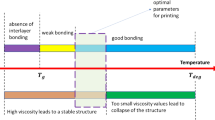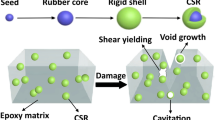This paper investigates the interrelation between plastic-deformation and heat-and-mass exchange during fabrication of roll-formed sections fashioned from rubberized metallic sheets. A generalized expression is derived for determination of their maximum bend angle. The stresses in the compression and tension zones of the metallic base and rubber covering, and the radii of the neutral layer of a rubberized sheet subject to plastic deformation are determined.





Similar content being viewed by others
References
I. V. Biryukov, Procedures for Rubberizing of Chemical Equipment [in Russian], Khimiya, Moscow (1967).
E. A. Popov, Fundamentals of the Theory of Sheet-Metal Stamping [in Russian], Mashinostroenie, Moscow (1977).
Yu. R. Osipov and S. V. Zamorenova, “On the fabrication of rubber-metallic entities by bending methods after vulcanization of the coverings,” deposited in the TsINTIkhimneftemash on Oct. 15, 1982, No. 904.
L. I. Ogorodov and Yu. R. Osipov, “Creep of polymeric materials in anti-filtration elements and serviceability problems of the elastomeric coverings,” in: Problems of Refinement of Asphaltic and Polymeric Anti-Filtration Structures in Water-Development Works [in Russian], Energoatomizdat, Leningrad (1985), pp. 117–121.
Yu. R. Osipov, Heat Treatment and Serviceability of Facings on Rubberized Entities [in Russian], Mashinostroenie, Moscow (1995).
Yu. R. Osipov and S. V. Meshcheryakov, “Experiment planning and mathematical method for investigation of attachment conditions for elastomeric coverings,” 7th All-Union Conf. on Planning and Automation in Scientific Research: Theses of Papers [in Russian], MEI, Moscow (1983), Part 1, pp. 194–196.
A. I. Malyshev and A. S. Pomogaibo, Analysis of Rubbers [in Russian], Khimiya, Moscow (1977).
E. I. Isachenko, Stamping with Rubber and Fluid [in Russian], Mashgiz, Moscow (1962).
Yu. R. Osipov and S. V. Meshcheryakov, “On the application of a generalized desirability function to quality-assessment problems with elastomeric facings,” Nadezhn. Kontr. Kachestva, No. 3, 16–21 (1983).
Yu. R. Osipov, Vulcanization Regimes and Prediction of Properties of Rubberized Facings [in Russian], VoPI, Vologda (1992).
Author information
Authors and Affiliations
Additional information
Translated from Khimicheskoe i Neftegazovoe Mashinostroenie, No. 5, pp. 3–7, May, 2011.
Rights and permissions
About this article
Cite this article
Osipov, S.Y., Osipov, Y.R. & Volkova, S.V. Effect of heat exchange during vulcanization on possible fabrication of rubberized entities by methods of plastic deformation. Chem Petrol Eng 47, 293 (2011). https://doi.org/10.1007/s10556-011-9462-6
Published:
DOI: https://doi.org/10.1007/s10556-011-9462-6




